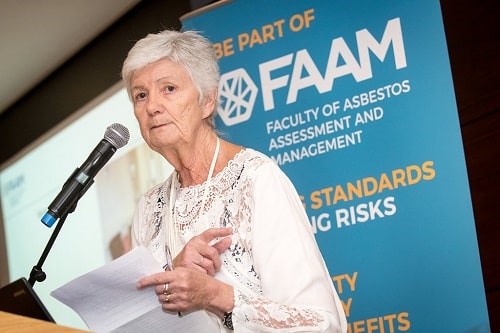Asbestos is killing more and more women every year. But evidence shows many still aren’t aware of the disease and how it can be acquired at work. This indicates they are more at risk.
Features
Clearing the air on asbestos dangers to women
What kind of work may expose someone to asbestos? According to the latest HSE data, excess deaths – that is higher than average deaths than might be expected – from mesothelioma are found on female death certificates in specific types of jobs. These are administrators, medical secretaries, teachers and women who work in banks and post offices.
About 5,000 people die every year due to asbestos-related disease in Great Britain. Out of these, 2,369 people died from mesothelioma in 2019 from exposures at work. According to Cancer Research UK, 17 per cent of mesothelioma cases in the UK, on average, are in females, and 83 per cent are in males.
 Teachers are at risk of exposure because many schools contain asbestos which becomes more dangerous as it ages and decays. Photograph: iStock
Teachers are at risk of exposure because many schools contain asbestos which becomes more dangerous as it ages and decays. Photograph: iStock
Cases increasing in women
However, mesothelioma is by no means a men’s only disease and the female cases are sadly growing at a faster rate. The rate of new cases of mesothelioma in females has doubled (97 per cent) HSE says since the early 1990s, but rates in males have increased by around half (51 per cent) in that time. The data for 2019 showed for the first time that male cases dropped by 9 per cent, whereas for women these remained the same.
Jo Gordon of the Derbyshire Asbestos Support Team (DAST), which has been operational since 2002, has noticed a change: “In the beginning [we were seeing] people who had had direct contact with asbestos. Now we are seeing more people with low level exposure and changing occupations. We are seeing more women diagnosed with mesothelioma.”
Where does exposure happen?
Asbestos may be in any building built before the year 2000, according to the government’s general guidance on asbestos. The All-Parliamentary Group on Occupational Safety and Health estimate it to be in more than 75 per cent of our schools, and the current government inquiry into HSE’s management of asbestos heard it is in 94 per cent of our hospitals.
This means exposure may happen in any building that women (or men) work in because asbestos was used in so many of our building materials (the substance was only banned in 1999).
 Broken ceiling tiles containing asbestos insulating board in a classroom. Any asbestos fibres would filter down into the classroom. From the report: Release of asbestos fibres in System Built Schools by Michael Lees, 2008.
Broken ceiling tiles containing asbestos insulating board in a classroom. Any asbestos fibres would filter down into the classroom. From the report: Release of asbestos fibres in System Built Schools by Michael Lees, 2008.
Teachers have contracted it pinning up pictures onto noticeboards, or through breathing microscopic fibres and dust disturbed by the general wear and tear of school life. Doors being slammed, or walls and columns hit if they contain asbestos insulating board can release the dangerous dust.
In 2006, Michael Lees conducted a study on drawing pins. The results found that for each insertion and removal of a single pin from an asbestos insulating board – such as the kind teachers might use to pin up children’s art – 6,000 fibres were released.
The control limit for asbestos is 0.1 asbestos fibres per cubic centimetre of air (0.1 f/cm3). The levels were “on a par with those for Artex ceiling strippers who work in controlled conditions wearing protective overalls and breathing apparatus”, said the report. Michael’s wife, Gina, was a teacher who died from mesothelioma which a coroner blamed on her exposure to asbestos in classrooms.
Or, like Pat Stone, who believed she contracted it through asbestos impregnated gauze mats used in science lessons – the kind placed under Bunsen burners. After every lesson, she would sweep the dust from the mats away.
A lack of awareness
And yet, there is still today both anecdotally and from research, a lack of awareness among women of the disease and how it starts.
Much material has come out from a recent study funded by Mesothelioma UK. Researchers from Sheffield University who carried out the work obtained data from around 2,000 patients using the Mesothelioma Outcomes, Research and Experience (MORE) survey, data from HASAG, an asbestos support group from the South of England and interviews.
The Gendered Experience of Mesothelioma Study (GEMS) sought to investigate men’s and women’s experiences of living with mesothelioma and to use the insights to identify how employers and health and legal professionals might best support them.
One of its main findings was that women of all ages and younger men lacked awareness of the dangers of asbestos exposure.
We spoke to Dr Stephanie Ejegi-Memeh, a researcher from the Mesothelioma UK Research Centre who conducted interviews for the report. She says: “Older men were really aware of asbestos related diseases. There may be a bit of fatalism for those men when they were diagnosed. ‘It’s got me, it got my friend down the road who worked in the same industry.’”
Younger men’s responses and women’s on the other hand were “completely shocked”: “They said ‘I’ve never heard of mesothelioma, I’ve never heard of asbestos.’ We didn’t get that with the older men. They hadn’t worked in heavy industry. That might be part of the reason. I imagine if I interviewed a young electrician he would have known.” The female patients often only understood after their mesothelioma diagnosis, and were more likely to respond with confusion, and occasionally, denial, says the report.
A risk for future exposure
Tony Hood, national head of asbestos strategy at social justice law firm Thompsons, believes this lack of awareness is a problem for the current generation of female workers.
Giving evidence to the House of Commons Work and Pensions Committee’s inquiry into asbestos in November 2021, he said: “Research shows women and younger men are less aware of the dangers of asbestos and by implication they are even less likely to recognise asbestos containing materials when they come across them.”
He said that although Thompsons are still being contacted for representation from workers in the traditional heavy industries, they are increasingly being contacted by people who believe they were exposed in the buildings they worked in.
“There is a changing landscape from heavy industry to all areas, including offices, schools and hospitals. The indirect exposure may present a greater risk to these occupations because they are less likely to be aware of what is asbestos and what the dangers are.”
 Mavis Nye: "Women lack knowledge more than men and it’s a shame." Photograph: BOHS
Mavis Nye: "Women lack knowledge more than men and it’s a shame." Photograph: BOHS
‘Setting is important’
So, what can be done? The Control of Asbestos Regulations 2012 applies to all non-domestic premises regardless of the nature of business or industry. This includes all industrial, commercial and public buildings such as hospitals and schools as well as factories, offices and shops.
The regulations require dutyholders to take “reasonable steps to identify asbestos within their premises and its condition”. They must prepare a “plan setting out how any risk will be managed” and they should “pass on information about asbestos containing materials to those who need it.”
Some argue that to reflect the risks in buildings containing asbestos we need to differentiate what constitutes a high risk job for men and for women.
The GEMs report categorises factory workers, administrators, health, sales and teaching jobs as high risk occupations for females. For men, high risk occupations included builders, carpenters and electricians. Stephanie Ejegi-Memeh says this helps to highlight the working environment as the source of risk: “The setting is important – the environment – not just the job you are doing.”
More and better information
There should be more done to educate workers in these settings about the risks. At the inquiry it was heard how hospitals aren’t providing basic training and information on the asbestos present in the buildings their workers work in.
Mavis Nye, who is a mesothelioma survivor and has won awards for her fearless campaigning about the risks from asbestos, says schools need to supply information. “The asbestos register should be there at reception in schools. Teachers don’t know, it’s a whole education process.”
But she adds we also need to make education about asbestos less scary and overwhelming. “I think we’ve probably given too much [information] and not [focused] it properly. Women lack knowledge more than men and it’s a shame. Young girls are panicking because they’ve walked past someone that’s doing some work. They ask me, ‘was there asbestos in that work?’ I do feel that schools should do more.”
Problems
Asbestos exposure for women is more complex and there’s no getting away from that. Aliyah Akram, a barrister working in industrial disease litigation, tells us: “Asbestos exposure in men’s professions tends to be pretty obvious – laggers, carpenters etc. They are less obvious for women, such as teachers or nurses.”
This impacts everything from the priorities HSE gives to inspection and enforcement of asbestos regulations, which tend to focus on construction and refurbishment, to calculating what can be termed an occupational exposure. Just one-third of mesothelioma cases among women can be said to be from occupational causes, says HSE.
Yet, that’s not to say they didn’t happen at work – it’s just harder to prove. Indeed, women are less likely to have a claim for compensation processed than men. According to the GEMS report, 11.6 per cent of women did not receive Industrial Injuries Disablement Benefit award compared to only 3 per cent of men.
“It’s difficult to see a fair way for the legal system to change to reflect these difficulties,” says Aliyah. “We have a fault-based system and within that it’s still important that a claimant proves their case on a balance of probabilities. Representation from specialist lawyers who know how to research and find supportive evidence and can bring in expert support is probably the key way of improving prospects for women’s claims.”
One thing that employers can do to right the balance and protect their male and female workforce equally is to talk about asbestos, especially if it’s present in their buildings. Asbestos has a habit of not responding well to being swept under the carpet. If we don’t take action on it now, then it will continue to haunt us.
Find the Gendered Experience of Mesothelioma Study (GEMS) here
Watch a video on mesothelioma and gender here
FEATURES

Stars, stripes and safety
By Belinda Liversedge on 02 July 2025
It seems like America today is rarely out of the news, particularly since President Trump won his second term. Our ‘special relationship’ with America has continued, with the country a strong pipeline for inspiration, products and trends.

The hidden risks of lithium-ion batteries
By Adrian Simmonds, QBE Europe on 01 July 2025
With UK fire services now tackling at least three Li-ion battery fires a day, it’s clear that stronger regulation and enforcement is urgently required to prevent the sale, use and modification of poor-quality and potentially dangerous batteries used in e-bikes and scooters.

Not leaving it to the Fates: the Golden Thread unspun?
By Andrew Gladstone-Heighton, Institute of Workplace and Facilities Management (IWFM) on 01 July 2025
Workplace and facilities management professionals play a vital role in creating and maintaining a ‘Golden Thread’ of digital information to ensure the ongoing safety of occupied higher-risk residential buildings. Now, new tools and guidance have been published to ensure everyone adopts a standardised approach when drawing together the required data and information.



